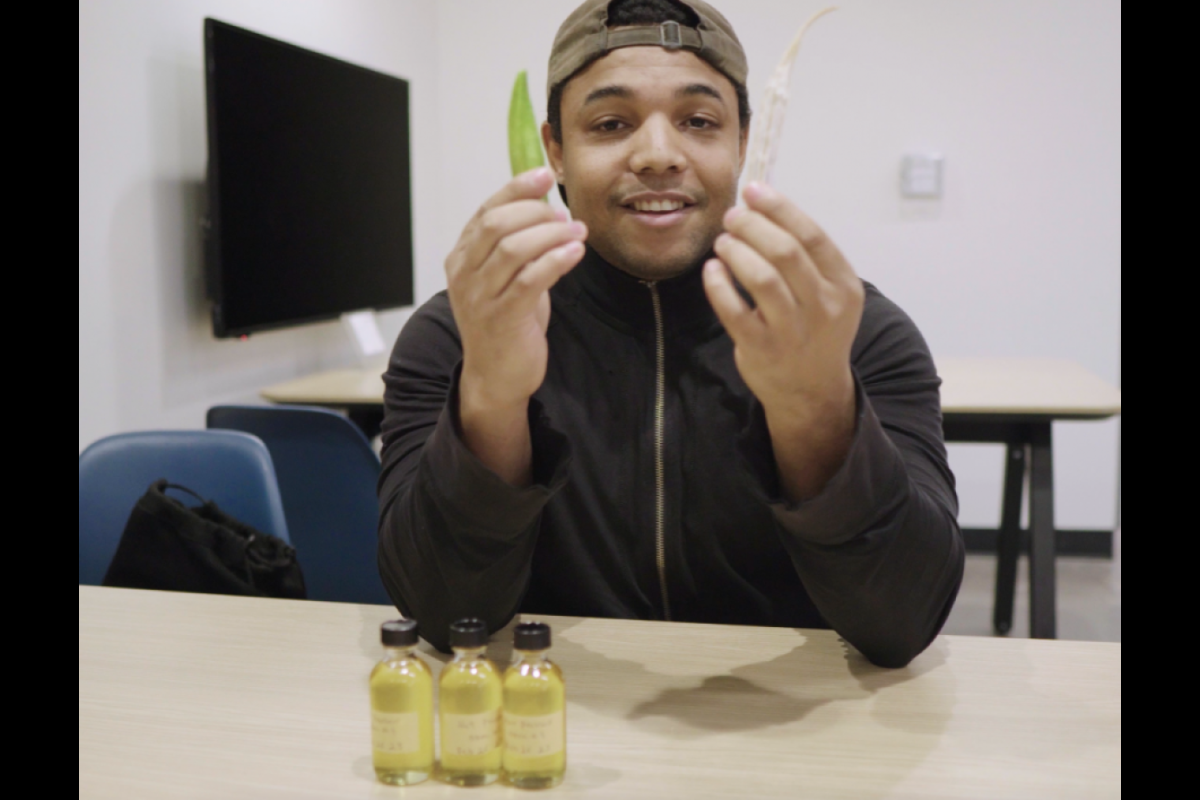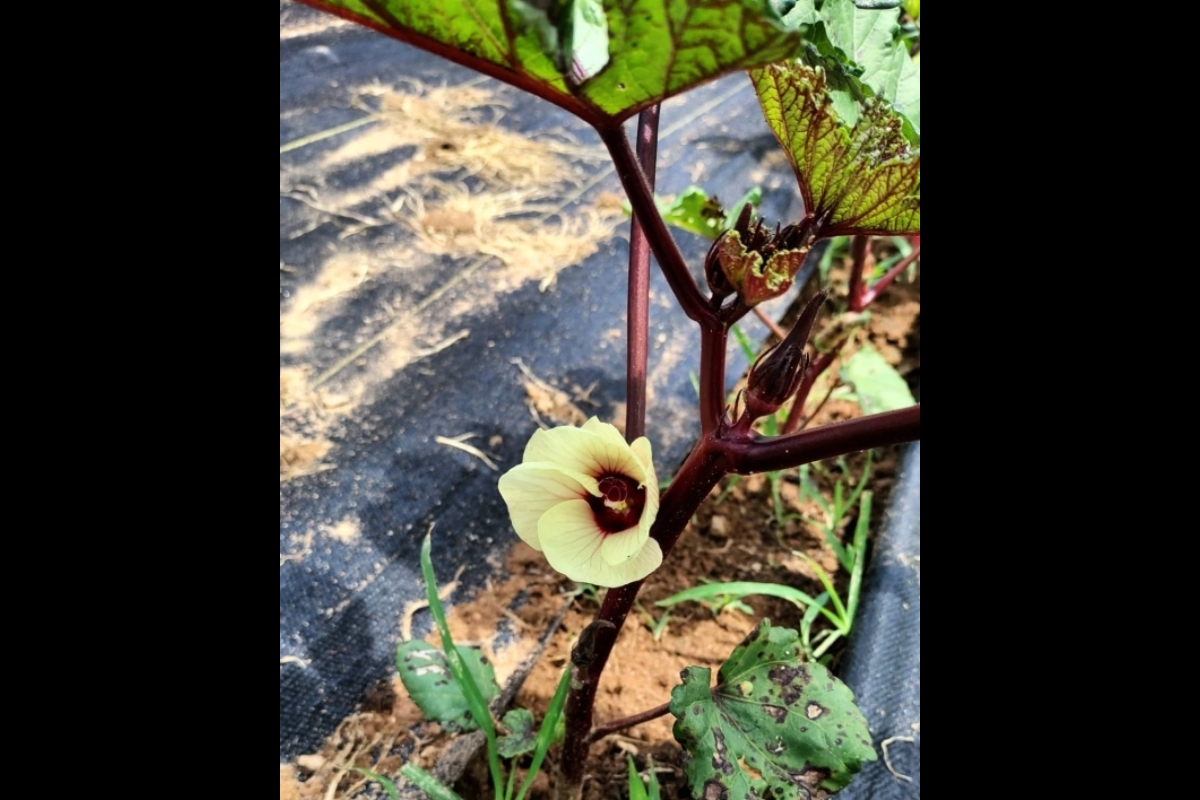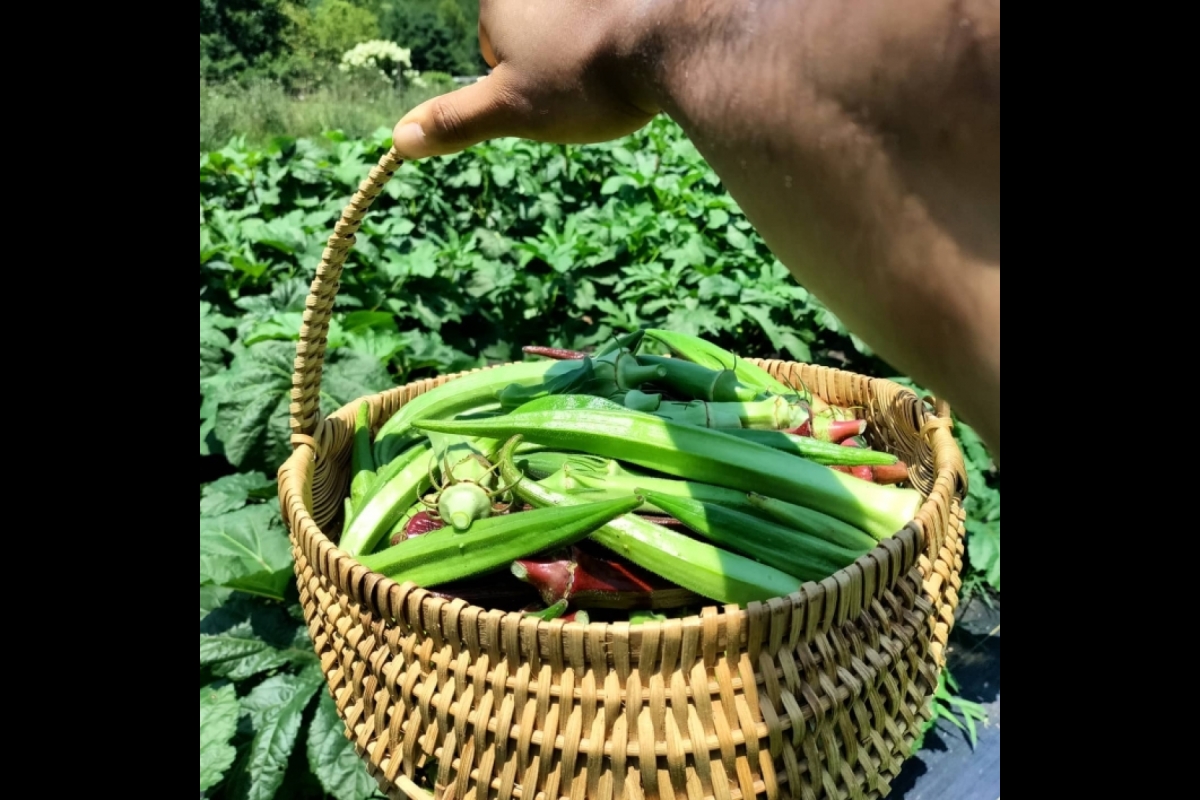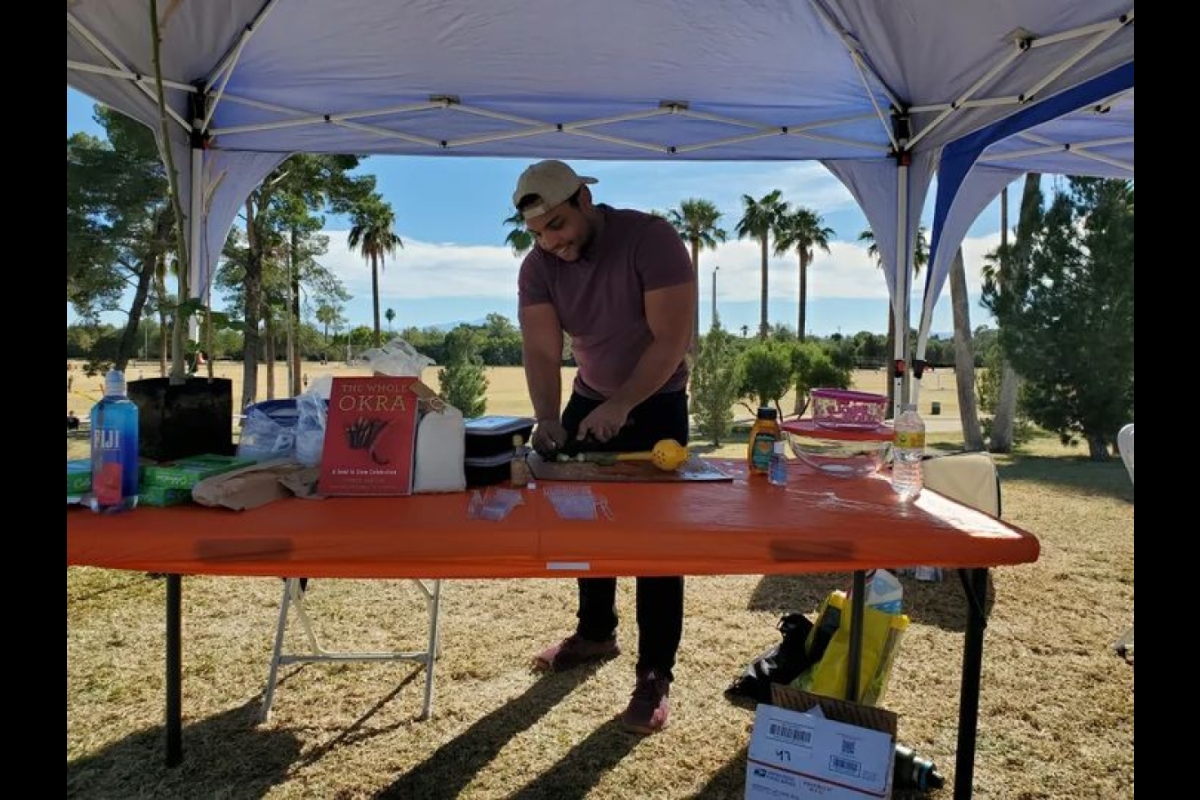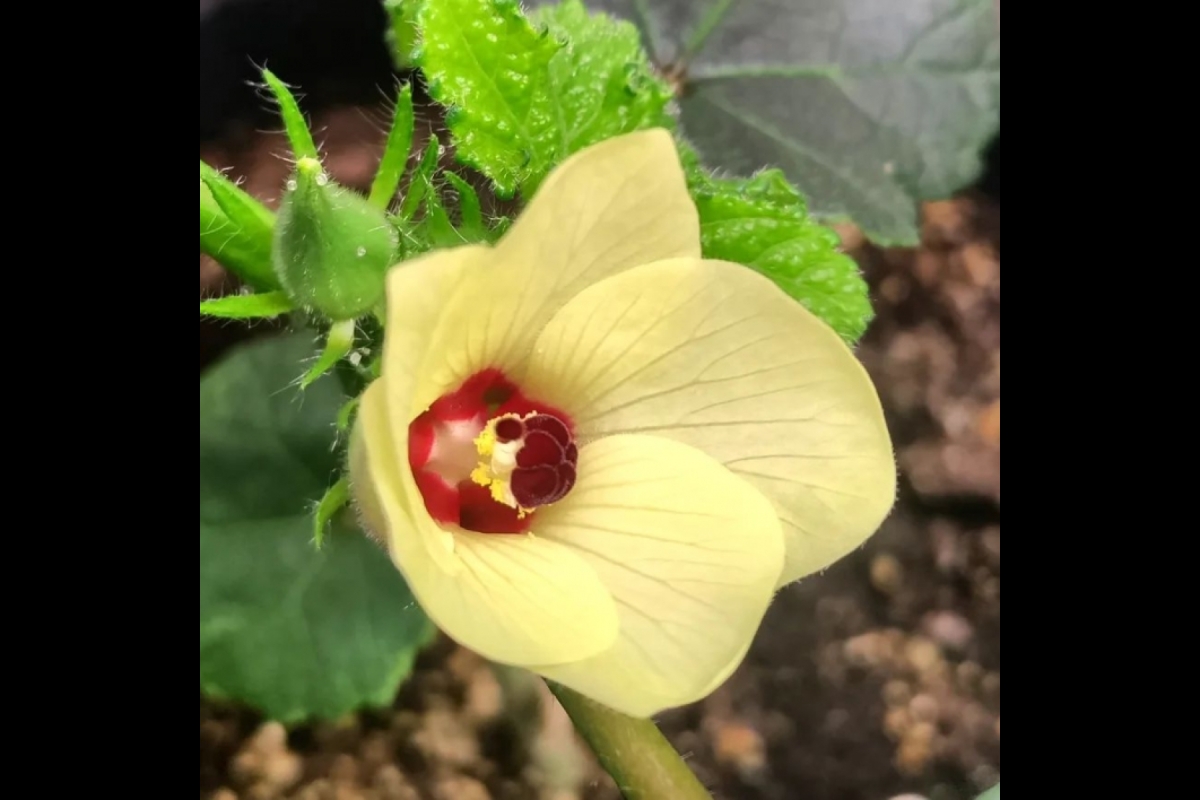Since we’re in the thick of NCAA basketball’s March Madness, let’s pretend you’re a member of the selection committee for a tournament of another kind, tasked with identifying invitees for a bracket challenge to determine the most powerful fruit-vegetable matter for our time.
Which superfoods might be shoo-ins for being the best? Kale? Pomegranate? Soybeans? Flax?
Botanist and ASU alumnus Jordan Collins, ’21 BS in applied biological sciences, would ask that you give serious consideration to team okra — an ancient plant packed with more than enough potential to propel it to the top of any power index.
Collins’ mental dossier for Abelmoschus esculentus is vast and compelling.
Nutritional, medicinal benefits
“Okra can sustain life. The flowers, fruits, leaves and seeds are all edible,” he explains. “And when the fruit and leaves are eaten together, it’s technically a complete protein.
“In addition to its healthy vitamin and fiber content, okra plays a role in anti-inflammatory processes and lowers risks of cardiovascular and metabolic disease. It’s high in margaric acid, an odd-numbered saturated fatty acid, which has been shown to act against skin cancer protein (heat shock protein 90) with higher effect than the drug dyclonine. It’s been shown to be beneficial in helping reverse the early stages of Type 2 diabetes and in supporting brain health.”
Some palates are turned off by the viscous compound inside the fruit, which intensifies when it’s cut open and comes into contact with water. But that’s actually where some of the most promising medicine is found.
Quoting a recent study funded by the National Institutes of Health, Collins noted: “Okra mucilage especially has demonstrated functional health properties through in vitro and in vivo studies, such as antitumor, antioxidant, antimicrobial, hypoglycemic and antiulcerogenic capacities, as well as the ability to bind cholesterol and bile acids, removing toxins from the liver.”
Capacity to weather climate change
“Okra is a fighter! It thrives in warm temperatures. It tolerates a degree of soil salinity,” he said. “It can survive drought as well as flood conditions.”
Collins cited with glee a recent study that compared the performances of okra and corn plants in water-logged conditions over 14 weeks: “All the corn plants died within the first four weeks. But okra? Okra outlasted the study!” he beamed. “At 14 weeks it was still producing flowers and fruit.”
“Okra could even help fight climate change,” Collins added. “It is a huge carbon sink — the plant creates druses, calcium oxalate crystals that capture carbon.”
Okra’s hardiness in water and root structure, he said, point to the plant being a successful hybrid that likely evolved on an alluvial plane, possibly in the southeast tip of Ethiopia.
“Expose the roots, and you’ll see it has both a longer tap root as well as a really shallow, fibrous root system that branches out when flooded,” he said. “This greater girth in roots will anchor it during flood. And its height, often well over 6 feet, keeps the fruit growing above the water channel.”
Okra historically stigmatized
Just in case all of the above isn’t enough evidence of this plant’s prowess as a superfruit: Okra, a member of the mallow family, is a relative of cotton, cacao and hibiscus, explained Collins, and shares some of the benefits we recognize in those plants.
“Okra is a self-pollinator,” he said, “but nature has also given the mallow family its own bee: Look for the rose mallow bee sleeping in okra’s five-petaled flowers."
The petals fold up after a day of bloom to form the okra we eat — the immature fruit, Collins explained.
“The mature fruit is woody and fibrous and has tremendous promise as a value-added product in sectors like manufacturing, energy, textiles, construction, agriculture — as a wood and biofuel alternative, a cotton alternative, animal feed, an inoculant for growing other crops.”
So, given okra’s promise for health and medicinal benefits, its capacity to help feed a planet during a time of climate change, its use in making clothing, shelter and fuel, why does the United States seem to have a blind spot when it comes to a plant with such extraordinary potential?
“Okra’s arrival in the Americas is connected to the trade of enslaved peoples. Okra was stigmatized, and first thought of as Black people’s food, and then poor people’s food,” Collins said. “The success of corn and soybeans has also suppressed a lot of innovation and diversification in the U.S. crop system. But with the world’s population now beyond 8 billion, and food scarcity and salinity of our lands a growing concern, it would behoove us to look at a model that works for other countries, like India, where okra is the backbone of feeding a nation with a population 400% larger than ours.”
Hands-on experiences at ASU Polytechnic campus and beyond
While Collins was completing his studies at ASU's Polytechnic campus, he was never too far away from the greenhouse.
He worked as a germplasm technician with Deborah Thirkhill, who manages the campus date grove. He also got in on the ground floor of the indoor farming lab, helping College of Integrative Sciences and Arts faculty members Yujin Park and Zhihao Chen set up the vertical farm.
“These professors, as well as Heide McILwraith and Ryan Merkley, were educational leaders,” Collins said, “and very supportive and inspirational to my work.”
“Even by then, Jordan had already developed an intense interest in Abelmoschus esculentus,” recalled Professor Douglas Green, “and was pursuing independent research. As an ASU undergraduate his knowledge and passion won him the Utopian Seed Project’s 2020 Tony Kleese Award.”
That award — which recognizes an early-career botanist and plant breeder doing visionary work toward an organic, open and just food system — led to a sponsored assistantship with the Utopian Seed Project the following summer, giving Collins several months of in-field experience in Asheville, North Carolina, focused on okra research.
“Growing it in North Carolina, I was able to see okra turn a quarter of an acre into a lush paradise. It was wonderful to see the beneficial insects that showed up. Ladybugs, butterflies, bees — pollinating, detesting against other kinds of crop-eating bugs. Okra is pretty resistant to predation. It made me wonder, too: Arizona is home to the largest diversity of bees in the world — might even more bees come here if there were large fields of okra?”
Now a master’s student in applied biosciences at the University of Arizona, Collins is doing an applied project over the next year investigating how the quality and color of light wavelengths affect the amino- and fatty-acid content of okra. He was the first to enter the program’s emphasis in sustainable bioeconomy and bioenergy.
Collins sees his future at the intersection of biotechnology, principled innovation and social entrepreneurship.
“I’m creating my own biotechnology company,” he said, “with one stream focused on products derived from okra, including okra-seed oil, a rich source of healthy unsaturated fatty acids. I’m working on a cold press and a hot press, with different smoke points.”
Collins is collaborating with Utopian Seed Project Executive Director Chris Smith, author of the James Beard Foundation Award-winning book “The Whole Okra: A Seed to Stem Celebration,” to develop a stable genetic line of okra seed with elevated oil levels.
“It usually takes six to 10 years to develop a stable seed hybrid. But we hope to leapfrog by trading cultivars across growing seasons,” he explained. “After the October frost in North Carolina, Chris sends me promising varieties whose parents have oil seed content above 20%, and then I continue the work and send cultivars back to North Carolina for the next growing season.”
Collins said it takes about 6 pounds of seeds to cold press 375 ml of okra oil.
“One acre of okra yields about 4,000 pounds of seeds per growing season,” he explained. “Say you have 10 acres, that’s a tremendous amount of okra seeds. And you may get more than one season in a year, depending on how much warm weather you have. Okra is a perennial in tropical areas.”
The more okra, the better
He’s driven by the blue ocean concept of an open market and collaboration.
“We need to make money to stand up the enterprise, but money will go back to building the community up,” said the U.S. Army infantry veteran. “People need to be fed, roads and schools built, teachers paid more – the more valuable your community is the better everyone is, including the environment.”
Collins invites anyone with a serious interest in the research to reach out, “be it from the point of view of chemistry, soil science, engineering, medicine — especially cancer, diabetes and heart disease — or other arenas.
“The okra research tent is large and so is its potential to help humankind,” emphasized Collins. “It offers something for everybody who is interested in finding new strategies and new opportunities for growing and using okra. I’m looking to do many areas of interdisciplinary research,” he shared, and said there are lots of opportunities for grant funding: “There are billions on the table for biotechnology research.
“The way I see it,” he concluded, “the more okra we consume or utilize, the better for humans and for the planet.”
Q&A: How to eat, grow okra
Collins shared some additional insights when ASU News sat down with him during Black History Month to learn more about his work with okra.
Question: What can you tell us about the history of okra?
Answer: Okra has been with humans for a long time. It seems to come to the forefront in times of great struggles of humanity; it came to the Americas from Africa during the trans-Atlantic trade of enslaved peoples. It traveled across societies during the crusades and likely during the spice and incense trades. We have gaps and holes in the story of where okra went on the planet, but okra is ancient. It’s rumored to even be mentioned in a pharaonic parchment.
Q: How would you recommend people eat okra?
A: If you want to get all the health benefits, use it as fresh as you can get it.
Slice the raw fruit in half vertically. Douse the inside and seeds with lemon, lime or grapefruit (my favorite) and then add a little honey or agave nectar. The acid in the citrus breaks down the slime and the honey helps infuse it with a texture our palates recognize. I was invited to set up an okra booth for Tucson Medical Center’s endocrinology unit recently and had people taste okra prepared this way – 97 out of 100 people who tried it liked it, even kids.
I blend it up and put it in fruit or protein smoothies. You can also substitute okra for any thickener in soups or stews, and you won’t lose any of the nutrients cooked that way. Throw it into your next chicken soup!
I’m developing a real love of using okra oil. Cooking salmon the other day I seasoned the fish with herbs de Provence, salt, pepper, thinly sliced lemons and then drizzled okra oil on top. The juices were so rich and brothy. It made the fish more satisfying and filling.
It’s also possible to bake using okra flour. The result is amazingly moist breads or cakes.
Try to steer away from eating it deep fried. You lose most of the health benefits. Instead, barbecue it, roast it or sear it whole with high heat. That also reduces the viscous element.
Q: Any tips for growing okra at home?
A: If you have access to a purple, burgundy or orange varietal, go for it, because of the health benefits of the anthocyanin content. Wait to plant your seeds until the first 4 inches of ground temperature reaches at least 65 degrees, and then you should be good to go. Make sure the plant gets enough water, nutrients and full sun. It’s frost sensitive — even light frost can cause it to go dormant.
Interested in learning more? Listen to the Okra Podcast's November 2020 interview with Collins and follow him on Instagram @lovesomegreen.
Top photo courtesy Henry Lu/ASU College of Integrative Sciences and Arts
More Health and medicine
College of Health Solutions medical nutrition student aims to give back to her Navajo community
As Miss Navajo Nation, Amy N. Begaye worked to improve lives in her community by raising awareness about STEM education and health and wellness.After her one-year term ended last month, Begaye’s…

Linguistics work could improve doctor-patient communications in Philippines, beyond
When Peter Torres traveled to Mapúa University in the Philippines over the summer, he was shocked to see a billboard promoting Arizona State University.“It wasn’t even near the university,” said…

Turning data into knowledge: How Health Observatory at ASU aims to educate public
This is how David Engelthaler described his first couple of months on the job as executive director of the Health Observatory at Arizona State University:“It’s been a little bit of drinking from the…

